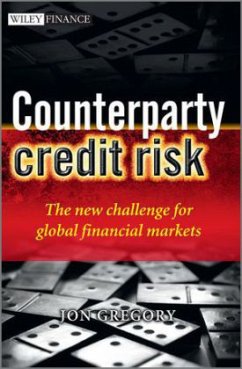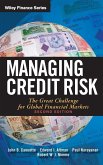The first decade of the 21st Century has been disastrous for financial institutions, derivatives and risk management. Counterparty credit risk has become the key element of financial risk management, highlighted by the bankruptcy of the investment bank Lehman Brothers and failure of other high profile institutions such as Bear Sterns, AIG, Fannie Mae and Freddie Mac. The sudden realisation of extensive counterparty risks has severely compromised the health of global financial markets. Whilst previously, only a few large dealers invested heavily in assessed counterparty risk, it has now become a key problem for all financial institutions, large or small.
This book is a technical guide to counterparty risk and all related aspects, explaining the emergence of counterparty as the key financial risk during the recent credit crisis. The quantification of firm-wide credit exposure for all trading desks and businesses is discussed in detail, alongside all relevant risk mitigation methods such as netting, closeout and collateral management (margining). Banks and other financial institutions have been recently developing their capabilities for pricing counterparty risk and these elements are considered in detail via a characterisation of credit value adjustment (CVA). Hedging aspects, together with the associated instruments such as credit defaults swaps (CDSs) and contingent CDS (CCDS) are described in full.
A key feature of the credit crisis has been the realisation of wrong-way risks illustrated by the failure of monoline insurance companies. Wrong-way counterparty risks are addressed in detail in relation to interest rate, foreign exchange, commodity and, in particular, credit derivative products. Portfolio counterparty risk is covered, together with the regulatory aspects as defined by the Basel II capital requirements. Many firms are setting up dedicated counterparty risk units or "CVA desks" and the management of counterparty risk within an institution is discussed in detail. Finally, the design and benefits of central clearing, a recent development to attempt to control the rapid grown of counterparty risk, is covered.
This book is a comprehensive guide to the area of counterparty risk. It is unique in being practically focused but also covering the more technical aspects (quantitative methods are covered thorough optional supplementary appendices to the main text). It is an invaluable complete reference guide for any market practitioner with any responsibility or interest within the area of counterparty credit risk. "Gregory has given us the first fully integrated treatment of counterparty credit risk. He delivers an authoritative and clear explanation of the nature of counterparty risk, as well as its measurement, market valuation, and management. He includes lessons learned from the financial crisis, and coverage of important related business issues, including collateralisation, capital requirements and central clearing. Essentially any risk manager, regulator, policy maker, or scholar concerned with over-the-counter derivatives markets will find this an indispensable guide."
Darrell Duffie, Dean Witter Distinguished Professor of Finance at The Graduate School of Business, Stanford University.
"Jon Gregory is an all too rare individual, a state-of-the-art quant who knows the limits of mathematical analysis and who can also express himself effectively with words. Counterparty Credit Risk: The New Challenge for Global Financial Marketsprovides a solid exposition of the conceptual and institutional aspects of this complex form of risk. He relies mainly on graphics and examples to illustrate his points, banishing most mathematical formulas to chapter appendices that can safely be skipped by the interested non-specialist. I highly recommend this book to any intelligent layperson who seeks a better understanding of counterparty credit risk and its public policy implications."
David M. Rowe, EVP for Risk Management, SunGard, Long-time Risk Analysis columnist for Risk magazine.
This book is a technical guide to counterparty risk and all related aspects, explaining the emergence of counterparty as the key financial risk during the recent credit crisis. The quantification of firm-wide credit exposure for all trading desks and businesses is discussed in detail, alongside all relevant risk mitigation methods such as netting, closeout and collateral management (margining). Banks and other financial institutions have been recently developing their capabilities for pricing counterparty risk and these elements are considered in detail via a characterisation of credit value adjustment (CVA). Hedging aspects, together with the associated instruments such as credit defaults swaps (CDSs) and contingent CDS (CCDS) are described in full.
A key feature of the credit crisis has been the realisation of wrong-way risks illustrated by the failure of monoline insurance companies. Wrong-way counterparty risks are addressed in detail in relation to interest rate, foreign exchange, commodity and, in particular, credit derivative products. Portfolio counterparty risk is covered, together with the regulatory aspects as defined by the Basel II capital requirements. Many firms are setting up dedicated counterparty risk units or "CVA desks" and the management of counterparty risk within an institution is discussed in detail. Finally, the design and benefits of central clearing, a recent development to attempt to control the rapid grown of counterparty risk, is covered.
This book is a comprehensive guide to the area of counterparty risk. It is unique in being practically focused but also covering the more technical aspects (quantitative methods are covered thorough optional supplementary appendices to the main text). It is an invaluable complete reference guide for any market practitioner with any responsibility or interest within the area of counterparty credit risk. "Gregory has given us the first fully integrated treatment of counterparty credit risk. He delivers an authoritative and clear explanation of the nature of counterparty risk, as well as its measurement, market valuation, and management. He includes lessons learned from the financial crisis, and coverage of important related business issues, including collateralisation, capital requirements and central clearing. Essentially any risk manager, regulator, policy maker, or scholar concerned with over-the-counter derivatives markets will find this an indispensable guide."
Darrell Duffie, Dean Witter Distinguished Professor of Finance at The Graduate School of Business, Stanford University.
"Jon Gregory is an all too rare individual, a state-of-the-art quant who knows the limits of mathematical analysis and who can also express himself effectively with words. Counterparty Credit Risk: The New Challenge for Global Financial Marketsprovides a solid exposition of the conceptual and institutional aspects of this complex form of risk. He relies mainly on graphics and examples to illustrate his points, banishing most mathematical formulas to chapter appendices that can safely be skipped by the interested non-specialist. I highly recommend this book to any intelligent layperson who seeks a better understanding of counterparty credit risk and its public policy implications."
David M. Rowe, EVP for Risk Management, SunGard, Long-time Risk Analysis columnist for Risk magazine.







